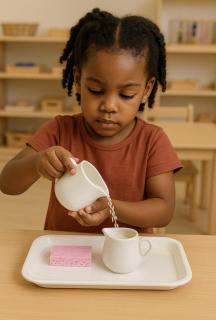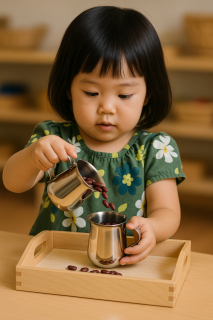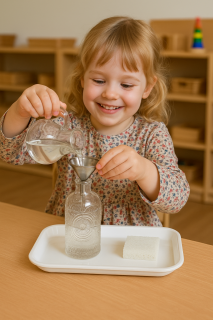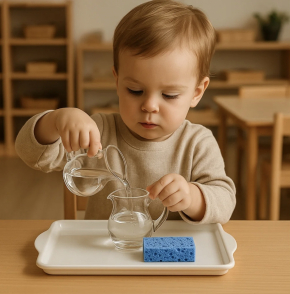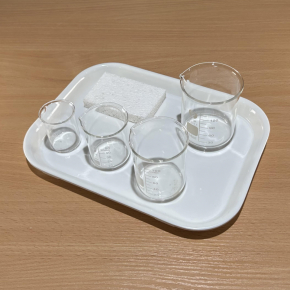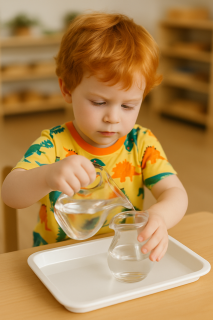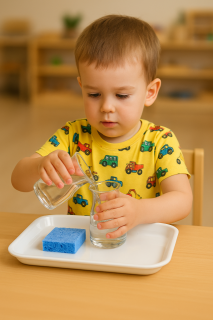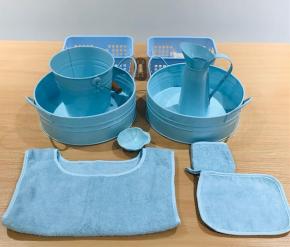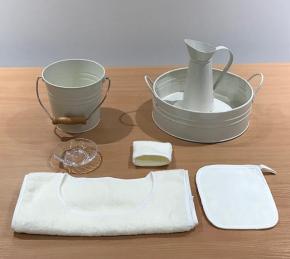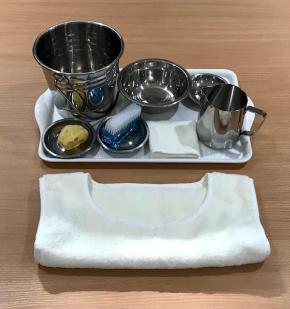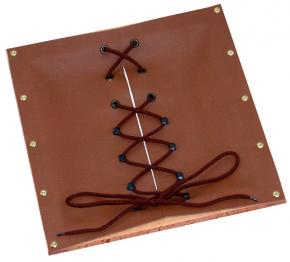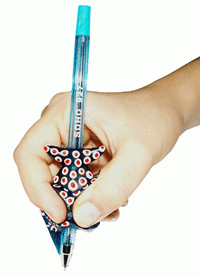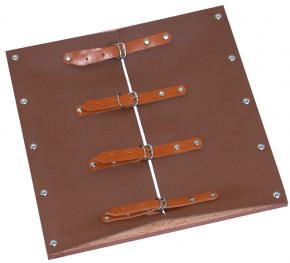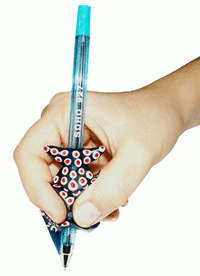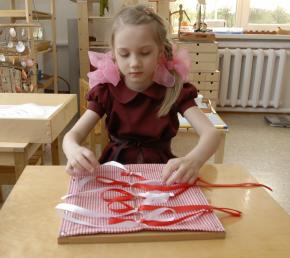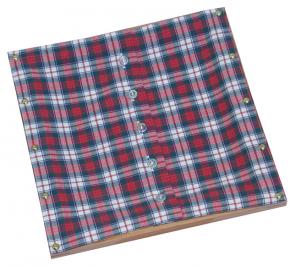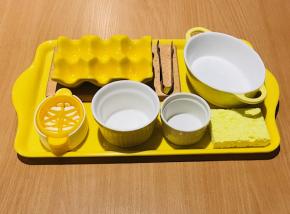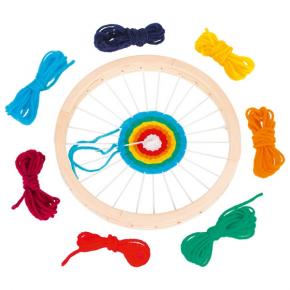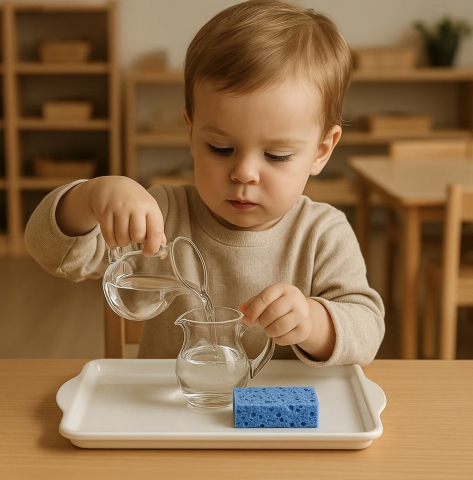
What Is Montessori Water Pouring? Montessori water pouring is one of the first practical life activities introduced to young children. At first glance, it may seem simple — just pouring water from one pitcher to another — but this foundational exercise plays a critical role in supporting fine motor development, concentration, coordination, and independent learning in early childhood. Using real, child-sized materials and movements rooted in purpose, this activity teaches children how to care for their environment and their own needs with precision and grace.
Why Practical Life Activities Matter?
In Montessori education, practical life activities are not just chores — they are carefully designed exercises that lay the foundation for lifelong learning. Activities like spooning, dry pouring, and water pouring isolate one movement at a time. This enables the child to build physical and cognitive control, preparing them for writing, math, and everyday tasks.
Educational Benefits of Water Pouring
✔Develops Fine Motor Skills
The act of grasping, tilting, and rotating the pitcher strengthens hand and wrist muscles — essential for writing and cutting.
✔ Enhances Hand-Eye Coordination
Children track the flow of water and must align their movements with visual input to avoid spilling.
✔ Promotes Concentration
This simple sequence (lift – pour – return) requires focused attention, helping children develop the ability to complete a task from beginning to end.
✔Fosters Independence
Montessori water activities are designed to be performed with minimal adult intervention. Children learn to rely on themselves — gaining self-confidence and pride.
✔ Introduces Control of Error
When water spills, the child sees it immediately. No need for correction from the adult — the child cleans up the spill independently and refines their technique. This is the Montessori concept of self-correction in action.
Materials You Will Need
- A tray with raised edges to define the workspace
- Two small ceramic, glass, or plastic pitchers with handles
- Water (colored with food dye if desired)
- A sponge or cloth for spills
- Optional: a small funnel or pitcher marked with a pouring line
Tip: All items should be proportionate to the child’s hands and easy to carry.
Step-by-Step Presentation
1. Invite the child to carry the tray to a work surface.
2. Introduce the materials by naming each object slowly and clearly.
3. Demonstrate the action:
- Hold the pitcher with both hands.
- Pour slowly into the second pitcher, stopping before it overflows.
4. Return the water to the original pitcher.
5. Invite the child to try, moving slowly and with care.
6. If a spill happens, quietly show how to wipe it with the sponge.
Use minimal verbal instruction — let the movement speak for itself. The child will observe, internalize, and repeat.
Variations and Extensions
- Dry Pouring – Use beans, rice, or lentils to isolate pouring without liquid cleanup.
- Pouring with a Funnel – Adds complexity and requires even greater precision.
- Pouring to a Line – Use a glass with a marked line to practice stopping at a visual point.
- Transferring with Dropper or Baster – Strengthens finger control and grip.
What Age Is Water Pouring Suitable For?
Montessori water pouring is ideal for ages 2.5 to 4, but even older children can benefit from more advanced versions. Start with dry pouring for toddlers, and then gradually introduce water-based exercises.
Common Questions
What if the child spills a lot?
Spills are expected! That’s part of the learning process. Children take pride in noticing and correcting their own mistakes.
Should I use real glass pitchers?
Yes — as long as they are child-sized and manageable. Breakable materials teach children to handle objects with care and respect.
What if the child wants to pour repeatedly?
That’s perfect! Repetition builds mastery. Let the child work as long as they like, as long as materials are handled respectfully and focus remains!
Why Montessori Water Pouring Matters
This humble activity holds the core of Montessori philosophy: respect for the child’s ability to learn through real work, freedom within structure, and the joy of self-discovery. Through repetition and mastery, children gain confidence — and the muscles, coordination, and habits that will serve them for life.
Explore Our Montessori Pouring Materials
Looking for beautiful, functional Montessori materials? Explore our full collection of pouring sets, designed for schools, homeschools, and Montessori-inspired homes.
Practical Tips for Success
• Begin with dry materials (like rice or lentils) for younger toddlers before transitioning to water.
• Always demonstrate slowly, with minimal words, and repeat if needed.
• Keep a sponge or cloth nearby, and model how to clean spills calmly and respectfully.
• Change the color of the water (using food dye) to make the process more engaging and easier to observe.
• Ensure pitchers are not too full — start with small amounts of water.
• Use consistent routines — same tray, same spot, same steps — to support memory and sequencing.
• Invite the child but never force the activity. Repetition comes naturally when the child is ready.
Real-Life Classroom Examples
In a Montessori preschool classroom, three-year-old Mia returns to the pouring activity tray every morning. Her concentration increases each day, and by the end of the week, she no longer spills any water. When another child accidentally spills, Mia offers a sponge without being prompted. This illustrates how the activity not only builds motor skills but also nurtures empathy, responsibility, and leadership.
Another example comes from a Montessori homeschool setting: a parent observed that their child, who previously struggled with grip strength, improved significantly after consistent use of the pouring set. Within two weeks, the child could hold a pencil more comfortably and began writing with more control.

